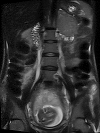Pheochromocytoma and pregnancy: a difficult and dangerous ordeal
- PMID: 22977377
- PMCID: PMC3436494
Pheochromocytoma and pregnancy: a difficult and dangerous ordeal
Abstract
Pheochromocytoma during pregnancy is potentially disastrous to the mother and fetus. Its ambiguous presentation is often mistaken for pre-eclampsia, although it may imitate other problems during pregnancy. Early diagnosis and timely, appropriate management reduces possible maternal and fetal complications. We identified a case of pheochromocytoma during pregnancy; the condition was initially diagnosed as pre-eclampsia complicated with gestational diabetes. Surgical intervention via left adrenalectomy was successfully performed in the second trimester. After surgery, all of the patient's medical problems nearly subsided and she did not require further treatment. However, her fetus displayed restricted intrauterine growth, and the patient eventually had premature delivery via a caesarean section. A multidisciplinary team to identify and treat pheochromocytoma is mandatory to ensure optimal conditions for tumour removal and to anticipate any possible catastrophic events.
Keywords: gestational diabetes; gynaecologic oncology; hypertension; pheochromocytoma; pregnancy; proteinuria.
Figures
Similar articles
-
Successful Pregnancy Outcomes After Laparoscopic Management of Pheochromocytoma.J Endourol Case Rep. 2020 Sep 17;6(3):170-173. doi: 10.1089/cren.2019.0139. eCollection 2020. J Endourol Case Rep. 2020. PMID: 33102719 Free PMC article.
-
Impact of maternal pheochromocytoma on the fetus and neonate.Gynecol Endocrinol. 2019 Apr;35(4):280-286. doi: 10.1080/09513590.2018.1540568. Epub 2019 Jan 6. Gynecol Endocrinol. 2019. PMID: 30614304 Review.
-
Pheochromocytoma in pregnancy: a case report and review of literature.Obstet Med. 2010 Jun;3(2):83-5. doi: 10.1258/om.2010.090063. Epub 2010 Jun 3. Obstet Med. 2010. PMID: 27582850 Free PMC article.
-
Management of pheochromocytoma during pregnancy. A multidisciplinary challenge: A case reports.Int J Surg Case Rep. 2023 Jul;108:108483. doi: 10.1016/j.ijscr.2023.108483. Epub 2023 Jul 7. Int J Surg Case Rep. 2023. PMID: 37423150 Free PMC article.
-
Calcium supplementation commencing before or early in pregnancy, for preventing hypertensive disorders of pregnancy.Cochrane Database Syst Rev. 2019 Sep 16;9(9):CD011192. doi: 10.1002/14651858.CD011192.pub3. Cochrane Database Syst Rev. 2019. PMID: 31523806 Free PMC article.
Cited by
-
Pheochromocytoma and Paraganglioma in Pregnancy: a New Era.Curr Cardiol Rep. 2021 May 7;23(6):60. doi: 10.1007/s11886-021-01485-4. Curr Cardiol Rep. 2021. PMID: 33961120 Free PMC article. Review.
-
The etiology of preeclampsia.Am J Obstet Gynecol. 2022 Feb;226(2S):S844-S866. doi: 10.1016/j.ajog.2021.11.1356. Am J Obstet Gynecol. 2022. PMID: 35177222 Free PMC article. Review.
-
Pheochromocytoma Leading to Multiorgan Failure in a Pregnant Patient: A Case Report.Clin Pract Cases Emerg Med. 2021 Nov;5(4):394-398. doi: 10.5811/cpcem.2021.6.52727. Clin Pract Cases Emerg Med. 2021. PMID: 34813427 Free PMC article.
References
-
- Ahlawat SK, Jairi S, Kumari S, Varma S, Sharma BK. Pheochromocytoma associated with pregnancy: Case report and review of the literature. Obstet Gynecol Surv. 1999;54(11):728–737. - PubMed
-
- Sarathi V, Lila AR, Bandgar TR, Menon PS, Shah NS. Pheochromocytoma and pregnancy: A rare but dangerous combination. Endocr Pract. 2010;16(2):300–309. - PubMed
-
- Wattanachanya L, Bunworasate U, Plengpanich W, Houngngam N, Buranasupkajorn P, Sunthornyothin S, et al. Bilateral pheochromocytoma during the postpartum period. Arch Gynecol Obstet. 2009;280(6):1055–1058. - PubMed
-
- Mannelli M, Bemporad D. Diagnosis and management of pheochromocytoma during pregnancy. J Endocrinol Invest. 2002;25(6):567–571. - PubMed
-
- Oliva R, Angelos P, Kaplan E, Bakris G. Pheochromocytoma in pregnancy: A case series and review. Hypertension. 2010;55(3):600–606. - PubMed
LinkOut - more resources
Full Text Sources


